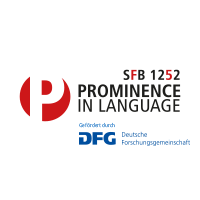KölnerKinderUni
The KölnerKinderUni at the University of Cologne is an exciting initiative that opens the doors of academia to young minds, offering a unique blend of lectures and hands-on workshops across all six faculties of the university. Designed specifically for children in grades 3 to 6, these events provide an inspiring glimpse into the world of science and research. The participation is completely free, making this an accessible and enriching experience for all children.
The CRC has actively participated in this initiative. More specifically, Maria Lialiou (A01) and Guendalina Reul (IDSL1) organized the workshop "Können wir Sprache im Labor untersuchen?/Can we study language in the lab?" which took place on March 18, 2024, at the XLinC lab. The previous year, on March 21, several members of the projects B02 and B05 coordinated the workshop "Ab ins Feld! – Sprachen unserer Welt erforschen /Into the Field! Exploring our world’s languages" that took place at the Philosophikum at the University campus.
"Can we study language in the lab?" XLinC lab, March 18, 2024
On the 18th of March, 2024, Maria Lialiou (A01) and Guendalina Reul (IDSL1) organized the workshop "Können wir Sprache im Labor untersuchen?/Can we study language in the lab?" at the XLinC lab. The conduction of this workshop was also supported by Prof. Dr. Petra Schumacher (A01, C07, C09, Z), Dr. Claire Patterson (C07) and Magdalena Repp (C07), Klaudia Kilter and Brita Rietdorf (Technical Assistants at the XLinC lab) and the student assistants at the time Hanna Buhl, Lisa Heßler, Anne Lützeler, Clarissa Selegrad, Sophie Sprengel and Robert Voigt.
The topics covered in the event are summarised in the call for participation of the KölnerKinderUni website. Maria Lialiou provided a detailed overview of the presentations and activities that took place during the workshop below:
"The workshop began with an interactive lecture that took place at the Physics Department building at the University of Cologne campus and was designed to introduce students to the field of linguistic research conducted in a laboratory setting. The lecture provided an overview of what linguists study and included images showing various types of laboratory equipment used in linguistic research to spark the children's curiosity. This segment aimed to familiarize students with the basic concepts and tools of the field.
Following the lecture, students participated in a guided tour of the XLinC lab. They were divided into small groups and rotated through several lab stations, each demonstrating a different research method. The stations included EEG (electroencephalography), reaction time measurement, interactive EEG activities, and eye-tracking technology. At each station, students received an introduction to the method and were given the opportunity to engage with the equipment directly.
To reinforce the learning experience, students were tasked with solving riddles related to the topics discussed during the lecture and the lab rotations. This interactive component was designed to enhance their understanding and retention of the material in an engaging manner.
Overall, the workshop successfully introduced students to the practical aspects of linguistic research in a laboratory environment. Through a combination of lectures, hands-on activities, and problem-solving exercises, students gained insight into the different methods and tools used by linguists, fostering an early interest in the science of language."
"Into the Field! Exploring our world’s languages." Philosophikum, March 21, 2023
On the 21st of March, 2023, projects B02 and B05 co-organised the workshop titled "Ab ins Feld! – Sprachen unserer Welt erforschen / Into the Field! Exploring our world’s languages". Elisabeth Clages, Mandy Lorenzen and Milo Reinmöller from project B02 "Split case marking and constituent order variation in East Africa" and Maria Bardají i Farré, Katharina Gayler, Sophia Meyer and Alessandra On from project B05 "Prominence related structures in symmetrical voice systems and Papuan languages" took part in organising and seeing through the conduction of the workshop.
The following report, written by student assistant Elli Clages (B02), offers a comprehensive account of the topics that were presented and the accomplishments of the children who participated in the workshop. Through her detailed narrative, Elli brings to life the dynamic and vibrant experiences of the young participants, showcasing their enthusiastic exploration and creativity.
"Through our KidsUni project, children briefly became linguists themselves, with the goal of discovering a part of the world’s linguistic diversity. They were tasked with investigating cryptic signs on their worksheets, just as adults do! There, they found sentences in an unknown language: Phonemic transcriptions, a translation of single words and of the complete sentence into German. Their task was to find out the language’s name, its special features, area of distribution and number of speakers.
The children dealt with five linguistic phenomena at five different stations: Reduplication, consonant clusters, tone, vowel length and the phoneme inventory. What are they and how do they work? What does this look like in other languages and in my own? They looked for examples in the sentences on their worksheets, slowly discovering how their language behaves with respect to these linguistic phenomena. We, project members of B02 and B05, explained and explained, using tools such as hand-crafted posters, flipcharts, whiteboards, PowerPoints and videos – and lots of bright colors. None of us got tired of puzzling and asking or answering questions.
The final step was the resolution. Using a chart, the children were able to find out what their language was called: Datooga, Tima, Totoli or perhaps Yali? Naturally, many new questions arose: How do people live who speak such a rare language? Where do they live? What does their language sound like? Our workshop concluded with a presentation of photos, conversations, and even a song from one of the remotest places in the world. On a large world map, the children could pinpoint the place where their language is spoken: In Tanzania, Sudan, Indonesia or Papua."



